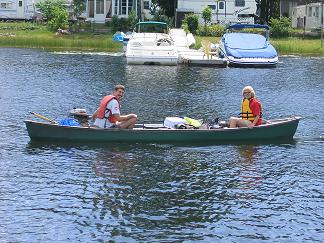
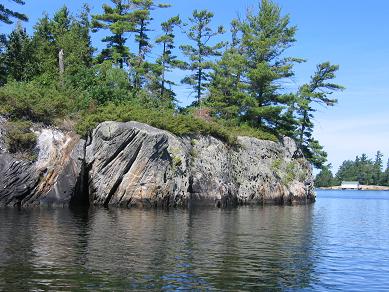
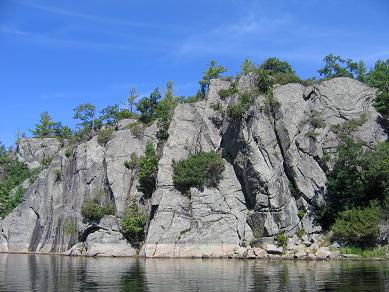
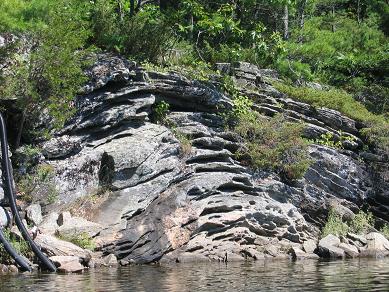
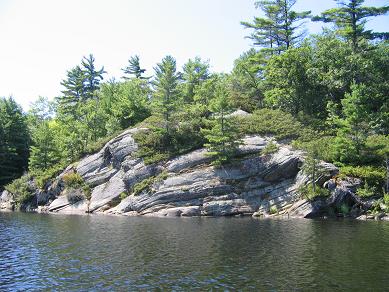
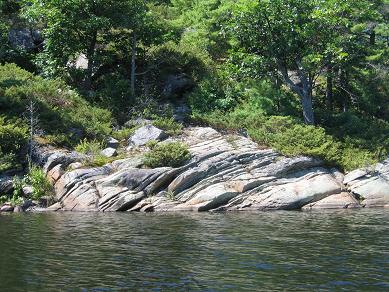
Camping at Beausoleil Island, 2008
|
Summary: About camping at Beausoleil Island, in the Georgian Bay Islands National Park system and an encounter with two endangered Eastern Massasauga Rattlesnakes.
|
In late August 2008, Dave and I loaded up the car with a giant old
canoe, 2 hp motor, and all the food and camping gear we would need for a few
days at Beausoleil Island in Georgian Bay, Ontario. I had not been camping in
decades and had never been to Georgian Bay, so it promised to be an experience.
Dave’s family has been going to that area for many years, all of Dave’s life and
then some. His aunt and uncle, Zina and Bob, maintain a boat up there and
usually anchor off the Island most of the summer (it was on their dinghy that
Dave was first introduced to sailing). When we arrived at Honey Harbour, the
starting off point, they met us at the dock, helped load the canoe, and offered
a yummy lunch on their boat at their marina, a three minute putter away.
Using the motor on the canoe, the trip to Beausoleil took about 45 minutes;
paddling would take up to 2 hours, as I understand it. (Regarding the motor,
Dave did some minor work on the 30-something-year-old motor as it hadn’t been
used in some years and it worked perfectly the whole time we were using it.)
| Dave Here: It’s a Johnson 2hp outboard from the early 70s; I
forget the exact year. Really, not much at all needed to be done to the
motor. I think it was about 7 or 8 years ago that it had been used last, and at that time I did a bit of work on it. I replaced the points and condenser, replaced the head gasket (I think?), replaced a broken choke knob, and overhauled the carburetor and got it adjusted just about perfectly. This time ‘round, all I did was give the onboard fuel tank a rinse with some clean gas and strapped it to the dinghy to test. It fired on the second pull and ran on the third pull – puttered away at both high and low speeds flawlessly. Pretty good considering I didn’t even bother to change or even inspect the spark plug! Oh, I did build a new gasket for the fuel filler cap so there wouldn’t be any leaking, but that was only a five minute job. For engines that don’t run very often, one of the biggest problems is old fuel left in the onboard tank and/or carburetor. Gasoline eventually degrades into a sort of varnish that will clog the fuel system. When putting the engine away, make sure you empty all the fuel out of the onboard tank and run the engine until it uses up all the remaining fuel in the carburetor and stops - it’ll make life much easier the next time you want to use it. |
Beausoleil is a huge island in the National Parks system with only small sections set up for camping or day trips. Georgian Bay was sculpted by glaciers scraping their way south about 15,000 years ago. There are tens of thousands of islands and thousands of little and big lakes and channels. The Canadian Shield is visible everywhere and astoundingly beautiful.
 |
 |
 |
 |
 |
 |
| Dave Here: Angi isn’t exaggerating… The area is actually referred to commonly as the 30,000 Islands. |
The high points of the three days in which we were there involved wildlife -
rattlesnakes, in fact. The Eastern Massasauga Rattlesnake, Ontario’s only
venomous snake may be found there. Fully-grown the snake is about two feet long.
The adults don’t get longer, just thicker in the girth. The snakes blend in well
with the underbrush; they have dark brown bowtie-shaped markings and sandy coloured background. They are extremely shy and leave whenever there is
activity.
On the second day of our trip, someone shouted that there was a snake, so
everyone within earshot went over to the area by the campground’s administration
kiosk. Several parks employees came over as well, to ensure the snake was not
disturbed, campers were safe, and to tell everyone about the species. They also
phoned the park warden immediately.
The Massasauga Rattlesnake is endangered and monitored very closely. When a
rattlesnake is encountered, the wardens document everything about the snake.
Snakes previously captured have microchips in their bodies, so the snakes’
routes are known. Captured snakes are moved to within a kilometer from where
they were found. Over a kilometer is out of their range and may be detrimental
to them.
|
The first snake we met that got away before the warden could come |
The warden with the second snake safely tucked away in the white bag. |
Unfortunately, the first snake we encountered managed to escape into the brush
and the warden did not find it. The next day, though, while on a hike through
the island paths, Dave and I encountered another, smaller, snake. I kept my eyes
on the snake while Dave ran back to our campsite to call the warden. The woman
from the answering service sounded excited to hear that there was a rattlesnake
and said that the warden would leave immediately for the island.
Once again, everyone came around to see the little snake. This time, though, the
snake stayed around and the warden captured him, without even touching him, and
placed him in a bag. The warden used a hand-held electronic device to determine
whether the snake had had the implant. This little guy was new to the system,
never having been caught before.
| Dave Here: The Eastern Massasauga Rattlesnake is definitely
a very shy species, whose first instinct is to disappear into the
underbrush when disturbed. While waiting for the warden to make the trip from the park headquarters in Honey Harbour, we had to constantly ask people to stay a good distance away from the snake. He was happy basking in a warm, open spot, but whenever anyone would approach he would head slowly off towards a heavily wooded area. After about 10 or 15 minutes of his inching closer and closer to the forest, I moved around to the other side of him, placing myself (at a Safe Distance – maybe 10 or 12’ away from him) between the rattlesnake and the brush that he was heading for in hopes of discouraging him from getting into it – he’d be next to impossible to keep track of and find in there. Fortunately, that slowed him down a bit, and in a few minutes the warden was on the scene and took over. |
The warden told us that he would take the snake back to the office, install a
microchip, determine the snake’s sex, and take a blood sample for DNA testing,
which is part of a project of a local graduate student. Also, this snake had
unusual colouring, a reddish hue on the top, all the way along his body, so the
warden was especially keen on examining him.
The warden spoke with a couple of little girls who were in our group of
spectators and explained what to do when you hear the rattle: stop walking; look
around for the source of the noise; when you see the snake, move two steps away
from it (the snakes can only strike half their body length, which is about one
foot for the adult snakes); yell for an adult to call the warden.
There are few snakes near the campsites and only about 50 are captured each year
and removed to another location.
One little girl was given the honour of naming the snake and she chose “Jacob”.
Dave has been going to Georgian Bay for his entire life and had never seen a
rattlesnake before and this week he saw two. He was thrilled.
|
|
Here's a link to the Georgian Bay Islands National Park web page about the Eastern Massasauga Rattlesnake.
© Copyright 2008
David S. Malar and Angelika Jardine. All rights reserved.
Home -
www.selfmadesailor.com
Website Design and SEO (Search Engine Optimization) by VentureIT.ca